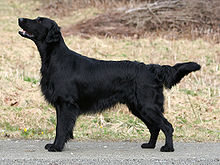
The Basset Hound is a short-legged breed of dog in the hound family. The Basset is a scent hound that was originally bred for the purpose of hunting hare. Their sense of smell and ability to ground-scent is second only to the Bloodhound.

The Bullmastiff is a large-sized breed of domestic dog, with a solid build and a short muzzle. The Bullmastiff shares the characteristics of molosser dogs, and was originally developed by 19th-century gamekeepers to guard estates. The breed's bloodlines are drawn from the English Mastiff and the extinct Old English Bulldog. It was recognized as a purebred dog by the English Kennel Club in 1924.

The American Cocker Spaniel is a breed of sporting dog. It is a spaniel type dog that is closely related to the English Cocker Spaniel; the two breeds diverged during the 20th century due to differing breed standards in America and the UK. In the United States, the breed is usually called the Cocker Spaniel, while elsewhere in the world, it is called the American Cocker Spaniel in order to differentiate between it and its English cousin, which was already known as "Cocker Spaniel" before the American variety was created. The word cocker is commonly held to stem from their use to hunt woodcock in England, while spaniel is thought to be derived from the type's origins in Spain.

The Cavalier King Charles Spaniel is a small spaniel classed as a toy dog by The Kennel Club and the American Kennel Club, that originated in the United Kingdom. Since 2000, it has grown in popularity in the United States and ranks as the 19th most popular pure-breed in the United States. It has a silky, smooth coat and commonly a smooth undocked tail. The breed standard recognises four colours: Blenheim, Tricolour (black/white/tan), Black and Tan, and Ruby. The breed is generally friendly, affectionate and good with both children and other animals; however, they require a lot of human interaction. Since they are a family dog, it is recommended to not leave them alone for long periods at a time. The expected average lifespan of a Cavalier King Charles Spaniel is under ten years.

Gastric dilatation volvulus (GDV), also known as gastric dilation, twisted stomach, or gastric torsion, is a medical condition that affects dogs in which the stomach becomes overstretched and rotated by excessive gas content. The word bloat is often used as a general term to mean gas distension without stomach torsion, or to refer to GDV.

The Kennel Club ("KC") is the official kennel club of the United Kingdom. It is the oldest recognised kennel club in the world. Its role is to act as governing body for various canine activities including dog shows, dog agility and working trials. It also operates the national register of pedigree dogs in the United Kingdom and acts as a lobby group on issues involving dogs in the UK. Its headquarters are located on Clarges Street in Mayfair, London, with business offices in Aylesbury.

Cocker Spaniels are dogs belonging to two breeds of the spaniel dog type: the American Cocker Spaniel and the English Cocker Spaniel, both of which are commonly called simply Cocker Spaniel in their countries of origin. In the early 20th century, Cocker Spaniels also included small hunting Spaniels.

The Goldendoodle is a cross-breed dog, which is obtained by breeding a Golden Retriever with a Poodle. The name, which alters "poodle" to "doodle" by analogy to "Labradoodle", was coined in 1992.

Poodles are a group of formal dog breeds, the Standard Poodle, Miniature Poodle and Toy Poodle. The origin of the breed is still discussed, with a prominent dispute over whether the poodle descends from Germany as a type of water dog, or from the French Barbet.
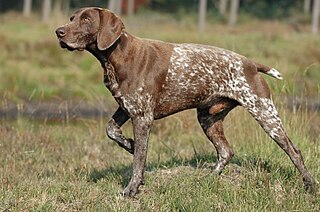
The German Shorthaired Pointer (GSP) is a medium to large sized breed of dog developed in the 19th century in Germany for hunting. A versatile hunting breed, being an all-purpose gun breed of dog suitable for both land and water, it is streamlined yet powerful with strong legs that make it able to move rapidly and turn quickly. It has moderately long floppy ears set high on the head. Its muzzle is long, broad, and strong, allowing it to retrieve even heavy game. The dog's profile should be straight or strongly Roman nosed; any dished appearance to the profile is incorrect. The eyes are generally brown, with darker eyes being desirable; yellow or "bird of prey" eyes are a fault. The tail is commonly docked, although this is now prohibited in some countries. In the current breed standard the tail is docked at approximately 40% of its length before it curves. In competition the dog is penalized if the tail is curved either up or down while the dog is moving. When the GSP is in classic point stance, the tail should be held straight out from the body, forming a line with the pointing head and body. Like all German pointers, GSPs have webbed feet. They are known for going after water fowl in the water.

Crufts is an umbrella term for an international canine event held annually in the United Kingdom. Crufts is centred on a championship conformation show for dogs but also includes a large trade show of mainly dog-related goods and services and competitions in dog agility, obedience, flyball and heelwork to music.

The Otterhound is an old British dog breed. It is a scent hound and is currently recognised by the Kennel Club as a Vulnerable Native Breed with around 600 animals worldwide.
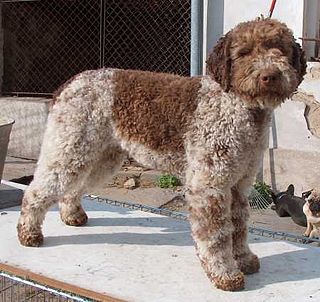
The Lagotto Romagnolo[laˈɡɔtto romaɲˈɲɔːlo] is a breed of dog that comes from the Romagna sub-region of Italy. The name derives from Romagnol can lagòt, meaning "water dog". Its traditional function is a gundog, specifically a water retriever; however, it is often used to hunt for truffles.

The Leonberger is a giant dog breed. The breed's name derives from the city of Leonberg in Baden-Württemberg, Germany. According to legend, the Leonberger was ostensibly bred as a "symbolic dog" that would mimic the lion in the town coat of arms. It is in the Working Group for dog shows such as Crufts, but not at the World Dog Show.

The Curly-coated Retriever is a breed of dog originally bred in England for upland bird and waterfowl hunting. It is the tallest of the retrievers and is easily distinguishable by the mass of tight curls covering its body. Curly Coated and Wavy Coated were the first two recognised retriever breeds, established as early as 1860.
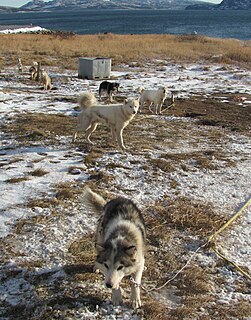
The Labrador Husky is a specific purebred dog. It is commonly mistaken for a Husky-Lab mix but in fact, it is its own breed. The Labrador Husky was originally brought to what is currently known as Labrador, Canada, in the 1300s by the Inuit. Its main purpose was to help the Inuit people survive in a highly demanding environment. The Labrador Husky was trained to pull sleds that transported goods. Labrador Huskies are known to be large but gentle dogs. The breed can grow to be bigger than the more commonly known Siberian Husky weighing in at 60-100 pounds. The dogs were later adapted to serve as a family pets. Labrador Huskies are good with children when trained properly and require a committed owner to maintain their needs. Some of these needs include proper grooming which involves regular brushing of its thick double coat. This breed does tend to have some serious health problems, including hip dysplasia, but in general, Labrador Huskies live anywhere between 10 - 13 years.

The Neapolitan Mastiff or Mastino is a large, ancient dog breed. This massive breed is often used as a guard and defender of family and property due to their protective instincts and their fearsome appearance.
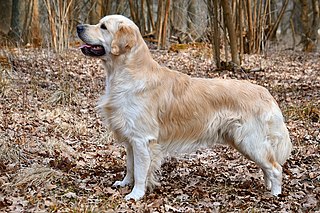
The Golden Retriever is a large-sized breed of dog bred as gun dogs to retrieve shot waterfowl, such as ducks and upland game birds, during hunting and shooting parties, and were named 'retriever' because of their ability to retrieve shot game undamaged. Golden retrievers have an instinctive love of water, and are easy to train to basic or advanced obedience standards. They are a long-coated breed, with a dense inner coat that provides them with adequate warmth in the outdoors, and an outer coat that lies flat against their bodies and repels water. Golden retrievers are well suited to residency in suburban or country environments. They shed copiously, particularly at the change of seasons, and require fairly regular grooming. The Golden Retriever was originally bred in Scotland in the mid-19th century.

Sh Ch. Vbos the Kentuckian, also known as Jet, was a Flat-Coated Retriever show dog bred and handled by Jim Irvine who won Best in Show at Crufts in 2011. He was descended from the 1980 Best in Show winner, Ch. Shargleam Blackcap, and placed Best in Show at several other shows around the UK including the Gundog Society of Wales and the National Gundog Association.
